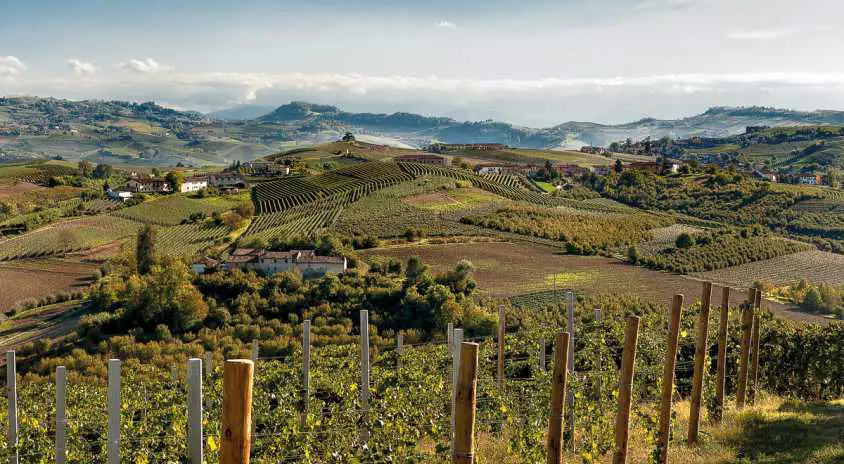Robiola Cheese and Medieval Piedmont
Robiola Cheese and Medieval Piedmont
Robiola Cheese and Medieval Piedmont
There are many different types of Robiola which differ in taste, aspect and texture. This Italian soft-ripened cheese hails from the Langhe region,
Do you know Robiola cheese? Well, probably yes, but you should also know that there are many different types of Robiola which differ in taste, aspect and texture.
Robiola is an Italian soft-ripened cheese hailing from the Langhe region, situated in the provinces of Cuneo and Asti, in the southern part of Piedmont, an area particularly popoular among the lovers of specialty food.
Although we do not know exactly when the production of Robiola cheese in the Langhe region began, we have documents that prove its existence already in the fifteenth century. Yet, there are some people who suppose that Robiola is much more ancient. Neither do we know hundred per cent the etymology of the name Robiola. Maybe it refers to the city of Robbio Lomellina and to the cheese which was produced there. Another theory supposes that Robiola derives from the Latin word “Rubeola” which means “reddish” and therefore refers to the reddish color the rind of aged Robiola.
What we can surely affirm is that Robiola is not only produced in the Langhe region, but also in the Piedmont’s province of Alessandria and in the regions of Lombardy and Aosta Valley. There, each producer of Robiola cheese has his own recipe and production methods. In fact, Robiola can be made of one milk, two milks or three milks, meaning that it is produced by mixing cow’s milk, sheep’s milk and goat’s milk.
Types of Robiola: flavors, textures and aspects
The flavor of Robiola depends largely from the milk or milks it contains, but its more or less pronounced taste is also connected with the aging time. Fresh Robiola has a sweet and milky taste. Its flavor and texture are quite similar to those of the Italian fresh cheese Stracchino. In its aged version, Robiola takes on a more intense taste, tangy and sometimes even spicy. Depending on the time of aging, you might even peceive some mushroomy nuances.
Therefore, the texture of Robiola varies from fresh and creamy to semi-firm with a deep yellow to slightly reddish rind. In the latter case, the aspect and the texture of Robiola are quasi identical to those of the French Brie.
Medieval Piedmont
Lovers of gourmet Italian food surely know the Langhe. Land of wines, of nuts, of truffles and, last but not least, of cheese. This is an extremely rich area form a culinary point of view but also from an historical one. A special article will be dedicated to Roccaverano, birthplace of a delicious DOP Robiola, and to the renowned town of Alba, its delicous truflles and cultural events. Meanwhile, let’s find out more interesting hidden places in the Langhe region and its surroundings.
Scattered over the hills of Piedmont and reflecting different traditions and architectures of distant origins, there are some villages that are perfectly preserved belonging to the network Sustainable Villages of Piedmont.
Sustainable Villages of Piedmont
The Langhe area is dotted with ancient villages built on its ridges, in stunning scenery, with towers and medieval castles, military forts or noble houses that you can visit. Hhistoric buildings open their doors to visitors as well as historic cellars dug into the tufa in the bellies of the hills, where the art of wine is mixed with forms and architectures, giving birth to true cathedrals of wine and art.
Bergolo now has only about seventy inhabitants. Still, the fascination that this tiny village emanates is remarkable, with its stone houses beautifully restored and with the panoramic position that dominates the steep slopes between the Bormida and the Uzzone Valley.
Walking through the cultivation of hazelnuts, hed to Levice, the Langa of the dry stone walls, of the truffle, of the farms appearing in the stories by Cesare Pavese and Beppe Fenoglio.
Visit the authentic village of Saluzzo, a small, charming town in the province of Cuneo, where the valleys of Monviso open into a plain rich in orchards. Here the 15th century urban solutions have been preserved almost intact in the old town. Saluzzo is full of narrow cobbled streets, steep stairways, churches and elegant palaces with balconies and terraces, gathered around hidden gardens. It is one of the most exclusive places in Italy for the lovers of antiques, art furniture and restoration. There, the crafts of wood and iron boasts a centuries-old tradition, valued by the annual fairs of Antiques and Furniture (respectively in May and September).
In the Cuneo area, but on the side Langhe, there is Neive, the land of Barbaresco and white truffle, which has, as Candelo, an ancient fortress. The plant of the town is still medieval: the red-roofed houses are close to each other and, from above the old town, you can enjoy great views of the surrounding vineyards.
Lose roofs, beams and wood belong instead to the Occitan culture and characterize the landscape of Chianale, in the province of Cuneo. We went far from from the Langhe area but we couldn’t help pointing out this beautiful town: a place full of charm, still strongly tied to the Alpine and Provençal culture proudly exhibited by its inhabitants.
Neraby there is the Aleve, the largest stone pine forest in Europe, on the slopes of Monviso.
Finally, visit one of the most beautiful places in Piedmont, Orta San Giulio, near Novara. Dear to writers and poets, Orta is a small town with very picturesque narrow streets.
The itinerary could continue and take you across many other marvellous villages on the hills of Piedmont. But definitely, you won’t have time enough. Therefore, enjoy this tour and relax!
This site contains product affiliate links. We may receive a commission if you make a purchase after clicking on one of these links.


